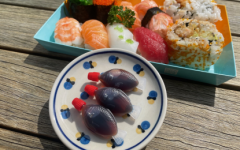- Thread Author
- #1
- Joined
- Sep 25, 2023
- Messages
- 33,987
- Reaction score
- 2,880
- Trophy Points
- 179
- Location
- Philippines
- D Bucks
- 💵5.530150
- Referral Credit
- 100
According to the report, the government of South Australia has banned the use of fish-shaped small soy sauce containers, commonly provided with takeaway sushi and "bento" boxed meals, as part of efforts to reduce plastic waste. The soy sauce containers were added on Monday to the list of prohibited single-use plastic products, which also include disposable straws.
The report also stated that state authorities claim that fish-shaped soy sauce bottles, which usually hold 2 milliliters to 3 milliliters and are often discarded rather than recycled, contribute to ocean pollution. The authorities also said the bottles pose a risk to wild animals, which may mistake them for food.
The authorities have instructed food companies and restaurants to provide refillable bottles on tables and to replace takeaway bottles with small pouches or other containers.
Additionally, fish-shaped soy sauce containers were invented in the 1950s by Japanese entrepreneur Teruo Watanabe, who founded Asahi Sogyo Co., a food-related materials maker based in the western Japan prefecture of Osaka. Their use spread as Japanese food became popular abroad.
Source: PNA/ (Jiji Press)
Image:

The report also stated that state authorities claim that fish-shaped soy sauce bottles, which usually hold 2 milliliters to 3 milliliters and are often discarded rather than recycled, contribute to ocean pollution. The authorities also said the bottles pose a risk to wild animals, which may mistake them for food.
The authorities have instructed food companies and restaurants to provide refillable bottles on tables and to replace takeaway bottles with small pouches or other containers.
Additionally, fish-shaped soy sauce containers were invented in the 1950s by Japanese entrepreneur Teruo Watanabe, who founded Asahi Sogyo Co., a food-related materials maker based in the western Japan prefecture of Osaka. Their use spread as Japanese food became popular abroad.
Source: PNA/ (Jiji Press)
Image:



